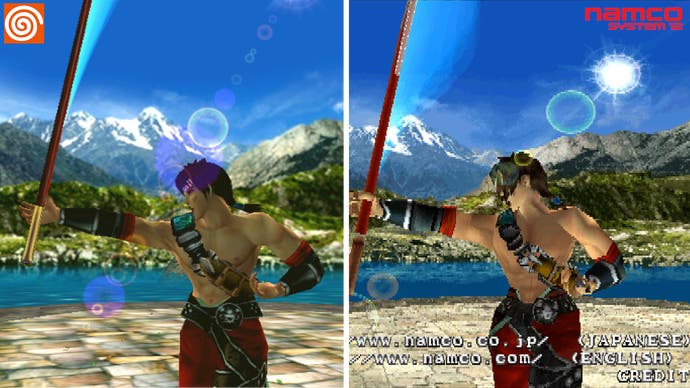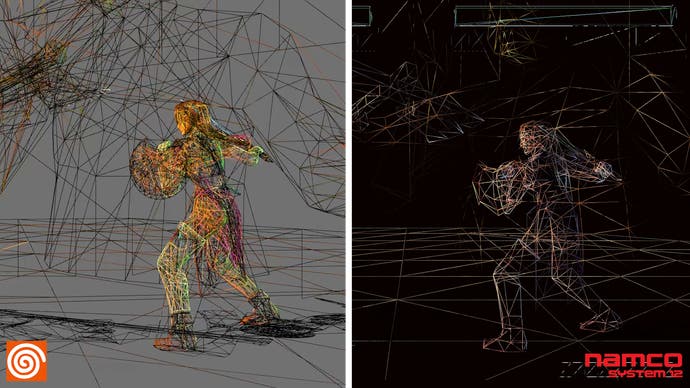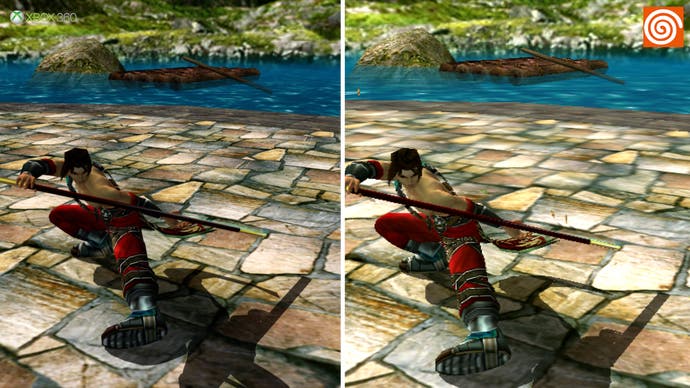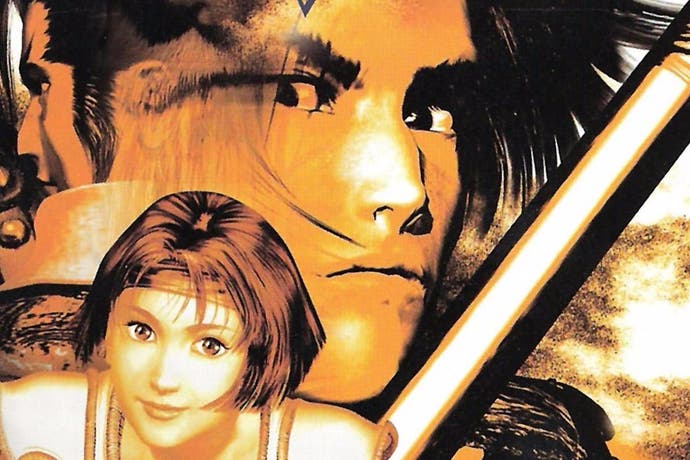DF Retro: Soul Calibur on Dreamcast - beyond 'arcade perfect'
Revisiting one of the best console launch titles ever made.
Arcade perfect - there was a time when this was the most sought after aspect of console gaming. Many titles got close, but few provided that absolutely authentic experience that perfectionists craved. Outside of ultra-deluxe consoles built for that purpose - like the Neo-Geo - most gamers could only dream about pixel-perfect home conversions of their favourite arcade titles. However, with the arrival of Soul Calibur on Sega Dreamcast in 1999, Namco delivered what some might consider the ultimate home port. This conversion didn't just match the arcade experience, it radically improved on it.
A sequel to the wildly successful Soul Edge (Soul Blade in its home form), the original release surfaced in 1998, running on Namco's System 12 arcade board. Soul Calibur made several key improvements over Soul Edge, starting with the eight-way movement system. While 3D fighters like Virtua Fighter 3 had experimented with z-axis dodging, Soul Calibur was perhaps the first to implement a full 3D eight-way movement system into the game.
This allowed for more tactical play as the player manouevres around each opponent. In addition, a more lenient command buffering system was implemented, making it easier to input combos - you could basically start inputting a move before a previous move is finished. The Soul Charge move was also added, which allowed you to temporarily boost attack power but leaves you open while executing it.
What really helped all this to work was the increase in animation quality and the doubling of the frame-rate (Soul Edge/Blade was a 30Hz title). The System 12 hardware, while still using similar parts to System 11, was clocked higher and was much more capable than a PlayStation console. Between the more complex animations, the dynamic lighting used to highlight attacks and the higher frame-rate, it was just not possible to bring the game to Sony's console. Sega's upcoming, more powerful Dreamcast would get the game instead.
By the time Namco got its hands on the development hardware, time was short and the 40-man team would have to rebuild the game in just seven months in order to meet the North American launch of the system. Things could have gone badly - after all, other arcade to Dreamcast ports didn't fare so well. Sega Rally 2, ported using Windows CE, was a mess with a frame-rate half that of the arcade while Virtua Fighter 3 was missing lots of detail - but Soul Calibur was something else.
Despite the time pressure and the tremendous difference in hardware capabilities, the result is nothing sort of legendary. Simply put - Soul Calibur was perhaps the first port of an arcade game to greatly outshine the original release. The age of arcade perfect had come to an end - we were in an era beyond. Every aspect of the game was touched in this conversion. The art was remade, models redesigned and new modes created. The team poured everything into Soul Calibur for Dreamcast, effectively remaking the visuals for the entire game - character modelling for example, received a massive boost to geometry and texture quality.
The upgrade in character detail is significant and one of the most notable changes to this version of Soul Calibur, but the remaking procedure extended to the fighting stages too. While both versions make heavy use of two-dimensional background images, the Dreamcast version uses additional geometry to build the scene. The floor itself is more detailed while surrounding objects are embellished with more triangles. That's not to say the System 12 version doesn't feature 3D backgrounds, of course, but it relies more heavily on 2D backgrounds.

Then, of course, we have the textures themselves. All the artwork was redrawn for the Dreamcast with higher resolution, higher colour assets and bilinear texture filtering. Textures are stored using 16-bits per pixel while System 12 uses lower quality palletised textures.Stage texture resolution is generally 256x256 on Dreamcast while, again, the textures are smaller on System 12. Even if model quality had remained consistent between the two versions, it's clear that the superior texture quality available on Dreamcast would have elevated the presentation. Soul Calibur features some of the cleanest, artefact free texturing we've found on the console. The results are simply excellent.
Another major improvement stems from the enhanced lighting. Lights, such as the one featured during the Nightmare battle, add extra flair to the environments during battle. There is dynamic lighting on System 12, of course, but the Dreamcast version takes this to the next level. Beyond that, modifier volumes are put to use, enabling much higher quality shadow rendering on Sega's machine. The particle system is improved as well with sparks, fire and strike effects all rendered at a much higher fidelity. The stages even received actual water with a beautifully animated texture used to enhance stage design - in some stages, background geometry is inverted and mirrored below the water surface to give the impression of reflections. The game runs more smoothly than the arcade version, locking to 60 frames per second with no hitches whatsoever.
According to Namco, Soul Calibur was an exercise in balance - every aspect of the visuals was carefully crafted to operate at 60fps while pushing the hardware in unique ways. The game pushes roughly one million polygons per second which may not match later Dreamcast titles, such as Dead or Alive 2, but the artwork is so carefully designed that it looks perfectly smooth.

It's incredible to consider that this conversion was completed in just seven months when you consider the number of options available. Aside from the typical modes, Soul Calibur introduces its own take on the Edge Master mode included in Soul Blade. Here, you travel around a map engaging in battles with special conditions. The points are then used in the art gallery to unlock loads of new features and options including extra stages and new missions. All of this is topped with a stellar soundtrack pulled straight from the arcade game.
Soul Calibur is as close to perfect as you're likely to get on Dreamcast, but Namco wasn't done with the game. Ten years after the debut of the arcade version, the title was re-released on Xbox Live arcade, with Xbox 360 users enjoy a direct, enhanced port of the Dreamcast code - albeit with some features removed.
On the surface, the Xbox 360 version looks awesome. The assets are identical to the Dreamcast version, but they run at 720p with MSAA enabled. The Dreamcast version, in comparison, is limited to 640x480 without any form of anti-aliasing, as was common at the time. On top of that, the obvious mip-map bands between textures on Dreamcast are eliminated on 360 with vastly superior texture filtering. This gives the impression of sharper textures at a distance. As you would expect, it runs at a locked 60 frames per second.

The final game was a tiny download - just 183MB - which seems incredible on the surface but then you realise that this version is missing content. The mission mode, for one thing, has been entirely scrapped which in turn, leaves players with little to do in single-player. All of the options are unlocked right from the start, which is useful for multiplayer but takes away any sense of progression, and the game winds up feeling a little slim. This is likely due to the strict requirements at the time - Microsoft did not allow games larger than 200MB on its service initially, which made it impossible for the entirety of the Dreamcast game to be included.
The good news is that Soul Calibur is also part of the Xbox One backwards-compatibility library, meaning that you can still play the game on modern hardware - and it should also run without issue on the upcoming Project Scorpio. Beyond that, if you want to play the original Dreamcast release at higher resolutions with cleaned up visuals, emulation is the only other option.
But there's one last version to discuss: the mobile version. Soul Calibur was released for iOS back in 2012 and Android in 2013. Unfortunately, it appears to have been removed from the iOS App Store but you can still get it on Android. It looks basically the same as the original Dreamcast game but ditches the mip-maps, resulting in sharper but slightly more aliased textures. On iPad, the game runs at 1024x768 - and it was never updated to support higher resolutions. It looks great but doesn't play well as it only uses touch controls with no external gamepad support. Thankfully the Android version does support pads, so this is another potential route forward for playing the game.
Revisiting the game this week has been a joy and highlights just how polished and enjoyable Soul Calibur remains to this day. While we've seen many arcade conversions since, across multiple generations, Namco's classic still stands out as the first to absolutely blow away its original arcade counterpart. It also remains one of the best launch titles ever released. If you haven't picked it up in a few years or have never played it, we highly recommend that you give it a shot. It's really that good.



